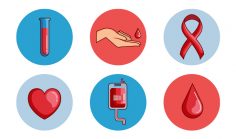Melanoma (or malignant melanoma) is a skin cancer that originates from the pigment-producing cells of the skin, known as melanocytes. Although often arising from moles, or nevi, they usually appear black or brown. However, melanomas may also appear skin color, pink, red, blue and white. Rarely, melanoma may begin in the eyes and even the internal organs, such as the intestine. Melanoma accounts for only 2% of all skin cancers, but is responsible for the vast majority of skin cancer deaths. As the most dangerous type of skin cancer, melanoma affects more than 120,000 people per year and kills 9,710 people annually in the United States—however, if melanoma is found and treated early, it is almost always curable. If the disease is not caught early, it can spread to other parts of the body, becoming harder to treat, and can be fatal.
This is a disease that affects people of all ages—in fact, people under 45 account for 25% of all melanoma cases. As the leading cause of cancer deaths in women 25 to 30, this is a disease that can be prevented from being fatal through vigilance and observation.
Melanoma is classified by the following sub-types:
- Cutaneous melanoma – melanoma originating from the skin
- Mucosal melanoma – melanoma originating from the mucosal areas of the throat, nasal passages, anus, or vagina
- Ocular melanoma – also known as uveal melanoma, or disease in the eye
- Metastatic melanoma – melanoma that has spread to lymph nodes or other more distant organs from its site of origin
After melanoma is diagnosed, tests will be done to find out if cancer cells have spread—or metastasized—within the skin or to other parts of the body; and allow your doctor to stage the cancer, which is critical in order to plan treatment.
The following tests and procedures may be used in the staging process:
- Physical exam and history
- Lymph node mapping and sentinel lymph node biopsy
- CT or CAT scans
- PET scans
- MRI scans with gadolinium
- Blood chemistry tests
The results of these tests are viewed together with the results of the tumor biopsy to find out the stage of the melanoma.
Cancer spreads in three ways within the body: through tissue, the lymph system and blood. When cancer spreads, or metastasizes, the metastatic tumor is the same type of cancer as the primary tumor. For instance, if melanoma spreads to the stomach, the cancer cells in the stomach are actually melanoma cells. The disease is metastatic melanoma, not stomach cancer.
The staging of melanoma depends on the following:
- Thickness of the tumor
- Whether the tumor is ulcerated (has broken through the skin)
- Whether the tumor has spread to the lymph nodes
- Whether the tumor has spread or metastasized to other parts of the body
The following stages are used for melanoma:
Stage 0 (Melanoma in Situ): In stage 0, abnormal melanocytes, which may become cancerous, are found on the outer layers of the skin or epidermis.
Stage 1: In stage 1, cancer has formed. This stage is divided into stages 1A and 1B.
- Stage IA: In stage IA, the tumor is not more than 1 millimeter thick, with no ulceration.
- Stage IB: In stage IB, the tumor is either:
- Not more than 1 millimeter thick, with ulceration; or
- More than 1, but not more than 2 millimeters thick, with no ulceration.
Stage II: Stage II is divided into stages IIA, IIB, and IIC.
- Stage IIA: In stage IIA, the tumor is either:
- More than 1, but not more than 2 millimeters thick, with ulceration; or
- More than 2, but not more than 4 millimeters thick, with no ulceration.
- Stage IIB: In stage IIB, the tumor is either:
- More than 2, but not more than 4 millimeters thick, with ulceration; or
- More than 4 millimeters thick, with no ulceration.
- Stage IIC: In stage IIC, the tumor is more than 4 millimeters thick, with ulceration.
Stage III: In stage III, the tumor may be any thickness, with or without ulceration. One or more of the following is true:
- Cancer has spread to one or more lymph nodes
- Lymph nodes are joined or matted
- Cancer is found in a lymph vessel between primary tumor and nearby lymph nodes, more than 2 cm away from the primary tumor
- Very small tumors are found on or under the skin, not more than 2 cm away from the primary tumor
Stage IV: In stage IV, cancer has metastasized to other places in the body, far from where it first started, like the brain, lungs, bones, and more.













